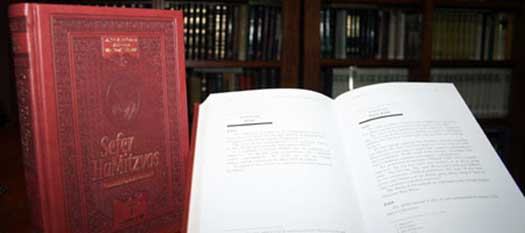
Maimonides’ Seminal Work Receives New Translation
Maimonides’ Sefer Hamitzvos, the seminal work of Jewish law that details each of Judaism’s 613 commandments, just received a scholarly but easily readable complete English translation from its Judeo-Arabic original. The two-volume set completes a decade-long project by Sichos-in-English, a Brooklyn-based Chabad-Lubavitch publishing house.
Studied daily by thousands the world over as part of the annual and three-year cycles in which the works of Maimonides — known as the Rambam — are learned, the Sefer Hamitzvos is divided into the 248 positive and 365 negative commandments that in total equal 613. It predates Maimonides’ magnum opus on Jewish law, the Mishneh Torah, and like most of his other works, was written in Judeo-Arabic, which for the most part is Arabic written with Hebrew vowels.
According to the late Rabbi Yosef Kapach, a Yemenite rabbi who dedicated his life to the teachings of Maimonides and their accurate publication, the Sefer Hamitzvos never received a proper translation to Hebrew until his publication of that work in 1971. Kaplach’s authoritative work was never translated into English.
“The 1971 [Kapach] edition,” wrote Rabbi Berel Bell, a member of the Rabbinical Court of Montreal, and the director of teacher training and e-learning for the Rohr Jewish Learning Institute, as well as the translator of the current edition, “was published with a new translation, completely rewritten footnotes, and is printed together with the original Arabic text.”
Kapach described why he came to translate the Sefer Hamitzvos again, when other translations already existed.
“My grandfather would teach [in Yemen] Sefer Hamitzvos publicly,” he wrote, “obviously from the original Arabic. Frequently, not all the listeners had the Arabic handwritten manuscripts, and some had the printed Hebrew translations … They would remark upon the differences between the translation and the original. Upon comparison, it became clear that in addition to these mistakes, there were many other kinds of inaccuracies …”
When Kapach heard in 1997 that Bell was translating the Sefer Hamitzvos into English, he wrote to him praising the move and instructing him, “I trust you will use my most recent edition, which was published with the original Arabic text … I also trust that you have been precise in your translation, as benefits our great teacher, Maimonides of righteous memory.”
According to Rabbi Yona Avtzon, director of Sichos-in-English, the translation of the Sefer Hamitzvos has its roots in recordings done shortly after the Rebbe, Rabbi Menachem M. Schneerson, of righteous memory, instituted the study of Maimonides as part of a daily learning regimen that Bell recorded, and was heard by tens of thousands over the phone and via cassette tapes. Today, those recordings could be heard on the Judaism Web site Chabad.org.
In 1984, the Rebbe suggested that to unite world Jewry, do so through Jewish learning. Therefore, he said, the Mishneh Torah should be divided so that each day, one would learn three chapters and complete learning Maimonides’ entire code in a little less than a year. Adding that many will not have the time to do that, the Rebbe said that one should learn at least one chapter, completing all the volumes within three years. Someone who does not even have time for that should learn Sefer Hamitzvos from the same commandments that are learned in the three-chapter cycle.
Kapach praised this study regimen. In fact, he dedicated a volume of his authoritative volumes of Mishneh Torah, which are praised to be the most accurate version of Maimonides’ magnum opus, to the Rebbe. “In honor of the Rebbe, Menachem Mendel Schneerson,” he wrote in his dedication, “who brought the learning of the teachings of Maimonides to life in the mouth of millions of Jews, and made Sefer Hamitzvos common in the mouths of thousands of children.”
The Sefer Hamitzvos study was considered mainly for younger students; several volumes were prepared for children. But today, the growing number of adults interested in joining this unifying endeavor necessitated a good translation of the Sefer Hamitzvos for them.
“”I heard that you have translated Sefer Hamitzvos of Maimonides from Hebrew to English,” Kapach wrote Bell. “I was happy to hear this because this fulfills the desire of the Rebbe, of righteous memory, to spread the words of Maimonides.”
Avtzon said that from those recordings, “we received many suggestions and comments, then we began translating the text and publishing them in pamphlets to receive additional critique.”
The decades of work, he continued, were worth it. Moreover, the translation became available during an auspicious time — days before the anniversary of the births of Maimonides and the Rebbe in this, the Hebrew month of Nissan.
The Rebbe was born on the 11th day of Nissan, corresponding this year to Friday, March 22. Maimonides was born on the 14th day of Nisan, corresponding to Monday, March 25.
“This,” said Avtzon, holding the volume, “is my birthday present to them.”














